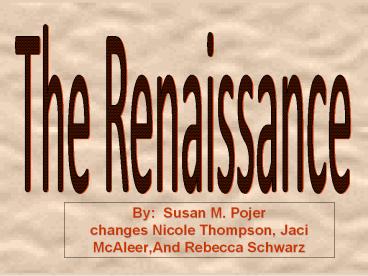Italian Renaissance Art
Title:
Italian Renaissance Art
Description:
By: Susan M. Pojer changes Nicole Thompson, Jaci McAleer,And Rebecca Schwarz The Renaissance 1350-1550 Rebirth of Greek & Roman Classics Begins in Florence, Italy ... –
Number of Views:656
Avg rating:3.0/5.0
Title: Italian Renaissance Art
1
The Renaissance
By Susan M. Pojerchanges Nicole Thompson, Jaci
McAleer,And Rebecca Schwarz
2
Florence - birthplace of the Renaissance!
3
Venice
4
The Renaissance1350-1550
- Rebirth of Greek Roman Classics
- Begins in Florence, Italy
- Intellectual Artistic growth emphasizing
individual worth achievement - Emphases value of the individual
- Question authority church
5
Artists scholars draw inspiration from ruins of
Ancient Rome
6
Scholars study ancient Latin manuscripts
preserved in monasteries
7
Christian scholars in Constantinople fled to Rome
with Greek manuscripts when Turks invade
Constantinople in 1453
8
Classical Worldly Values
- Humanism an intellectual movement focused on
human potential achievements - Humanists influence artists architects to carry
on classical traditions - Rediscover classical education in history,
literature, philosophy - Society becomes secular worldly (concerned
with here now) rather than spiritual
9
The Renaissance Man
- Broad knowledge about many things in different
fields. - Deep knowledge/skill in one area.
- Able to link information from different
areas/disciplines and create new knowledge. - The Greek ideal of the well-rounded man was at
the heart of Renaissance education.
10
Renaissance Woman
- Educated and knew the classics
- Expected to be charming and inspire art
- Wealthy women supported artists and built art
collections - Isabella DEste
11
Women become Patrons of Art beautify cities by
financing the arts (painting, architecture,
sculpture)
12
William Shakespeare
- Writes during the Elizabethan Age
- Draws on classics for inspiration plots
- Plays examine human flaws
- Vernacular authors write
- in their native language-
- Not Latin -to express their
- ideas
13
Gutenberg Printing Press 1440
- Produce books quickly cheaply
- Prints complete Bible in 1455
- Gave the ability to produce 100s of copies of a
single work - People can read Bible for selves
- Non-religious books are published
14
Characteristics of Renaissance Art
15
Perspective
- The Trinity
- Masaccio
- 1427
Perspective!
Perspective!
Perspective!
Perspective!
Perspective!
Perspective!
Perspective!
First use of linear perspective!
What you are, I once was what I am, you will
become.
16
The Sistine ChapelMichelangelo Buonarroti1508
- 1512
17
1. Self-Portrait -- da Vinci, 1512
- Artist
- Sculptor
- Architect
- Scientist
- Engineer
- Inventor
1452 - 1519
18
- Vitruvian Man
- Leonardo daVinci
- 1492
TheLuomouniversale
19
Parody?The Best Form of Flattery?
A Macaroni Mona
20
A Picasso Mona
21
An Andy Warhol Mona
22
A Monaca Lewinsky
23
The Last Supper - da Vinci, 1498 Geometry
24
The Last Supper - da Vinci, 1498
vertical
horizontal
Perspective!
25
A Da Vinci CodeSt. John or Mary Magdalene?
26
Leonardo, the ArchitectPages from his Notebook
- Study of a central church.
- 1488
27
Leonardo, the Scientist (Biology)Pages from his
Notebook
- An example of the humanist desire to unlock the
secrets of nature.
28
Leonardo, the Scientist (Anatomy)
Pages from his Notebook
29
Leonardo, the Inventor
Pages from his Notebook
30
Leonardo, the Engineer
Pages from his Notebook
Studies of water-lifting devices.
A study of siege defenses.
31
Sum It UpArt
- Art draws on styles of classical Greece Rome
- Art portrayed people nature realistically
- Artist create secular works (not just religious)
- Writers use vernacular to express ideas
- Arts praise individual achievement
32
Sum It Up - Society
- Printing Press makes information available and
inexpensive - Availability of books increased desire for
learning and a rise in literacy - Published accounts of new discoveries, maps,
charts led to further discoveries - Published legal proceedings made the laws clear
so that people were able to understand their
rights - People began to question political and religious
practices































